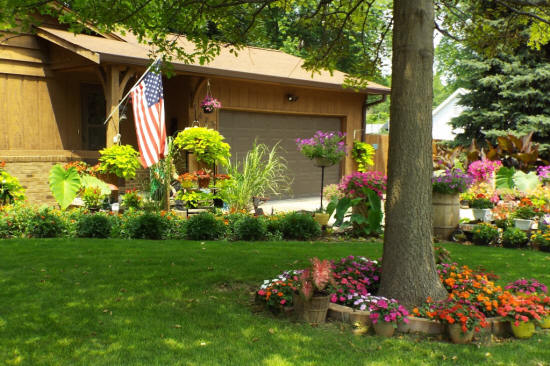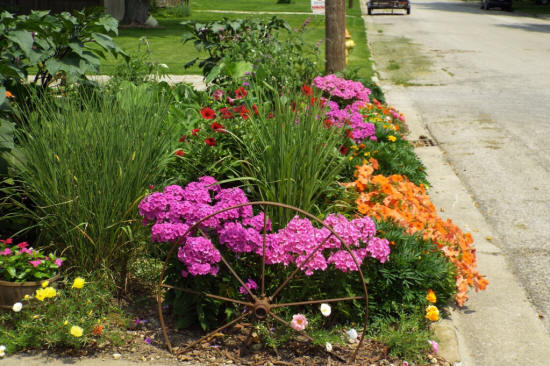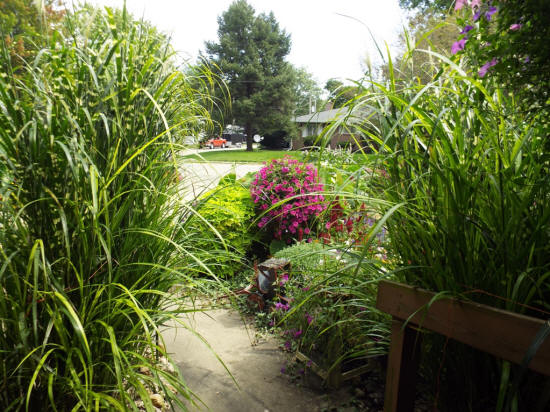|
 For other’s smaller is better, and dainty petite
beds scattered about a lawn can have the same impact, maybe with a
more subdued “wow factor’ but none-the-less the beds are still
capable of getting attention, if they are put together well. For other’s smaller is better, and dainty petite
beds scattered about a lawn can have the same impact, maybe with a
more subdued “wow factor’ but none-the-less the beds are still
capable of getting attention, if they are put together well.
So, how does one do that? How do you “put together well” a bed that
will grab the attention of the passersby?
Rule number one has to be plant what you like. If you are planting
for show and don’t love the flowers you are planting, you won’t love
the final outcome, you won’t care about caring for them, and soon
the smack-in-the-face that the neighbors see is not a beautiful
flower bed, but rather an unsightly mass of dead and dying plants.
So, if some popular gardening show on television touts the textural
beauty of Cone Flowers and you hear they are all the rage and
something you have to have in your garden, but ... you don’t like
them, then don’t plant them!
If you are a novice gardener, your next question may be “how do I
know what I like?” Simple answer, what makes you smile?

Here are 10 happy plants that would like to make friends with you.
These are all annuals, so as you ‘shop’ this video make note, do you
want to change up your flower beds with new plants every year, then
these are the plants that live one season.
VIDEO:
Top 10 annuals to grow this summer
Now if you want something that comes up year after year, perennial,
there are plenty to choose from. In the first year, they won’t be as
full and lush as in the years to follow. One common mistake people
make when planting perennials is that they plant too close and the
plants don’t have room to grow to their full capacity in the second
and third years.
For ideas on perennials, here’s a great picture show for you.
VIDEO:
15 favorite
perennial flowers to beautify your garden
Your second step needs to be to decide where you want to plant your
garden. Once you have a location in mind, then consider what is
going on around that area. For example, if you want to plant along
the front or sides of your home, then think about what the backdrop
for the bed is going to be. A dark colored siding or brick wall will
swallow up dark colored plants. Choose bright colors such as
yellows, white, orange, and flame reds. On the other side of the
coin white siding or light colored brick can take heavier more jewel
toned colors such as deep purples, reds, oranges, and greens.

If you have a tree in the lawn that somehow looks out of place, then
dressing it up with flower beds around the trunk may make it look
more inviting. Be sure to choose shade loving plants for that area.
Shade lovers include Impatiens, Begonia, and Fuchsia of the blooming
varieties; and Coleus is a colorful non-bloomer that can still add
texture and flash around the base of a tree.
Here are some other suggestions for growing a colorful garden in the
shade. Remember, shady areas extend past the base of the tree, so
watch your lawn and see when the sun shines in a particular patch
and when it does not. Shade, for the sake of plants, means the area
spends much of the time shaded from the sun, but will still have
periods of at least partial sun.

VIDEO:
19 Colorful
plants for shade gardens
Next, consider the proportions of your bed. To create the best eye
appeal, you may not want to go with a “flat bed” where all the
plants are basically the same height. While that approach can work
in a large area where the garden can be viewed from a slightly
elevated area, for the most part, flat beds will equal only the
foreground plants offering eye appeal.
[to top of second column] |
 Add height to the bed using taller growing plants.
Depending on the area you are planting, these plants could be only
slightly taller, then stair-stepping down to ground level plants, or
you may want something very tall to fill a void in the background,
and stagger plant heights downward throughout the bed.
Tall growing plants could include Cannas, Caster Bean, Angel
Trumpet, or Elephant Ears. Typically these plants have the ability
to grow very tall, and in the appropriate area, give you a great
foundation for a flowering garden that is massive and at the same
time somewhat compact.

You can also create that tall focal point area with props. Decide on
a centerpiece for the garden that gives the desired height, then
plant around it.
This video shows a few examples of how high and low plantings can go
together, and also working with the home or a component of the home
as the tall background for the garden. Some of the items in this
video are really just for fun, so enjoy.
VIDEO:
50 amazing
flower garden design decorations ideas
For some, flower beds may not be practical, but that doesn’t mean
you can’t have big, bold, beautiful flowers in your lawn. Many
plants love pots, such as petunia, begonia, impatiens, and more.
Here are two fun to watch videos that may ‘plant’ some ideas for
your garden
VIDEO:
38 creative
container garden ideas
VIDEO:
100+ garden
decoration ideas, potted plants, funny garden pots, pot gardening
(see if you can spot the fake
flowers in this video)
 Finally, when you
get ready to buy, whether it be plants, bulbs, or seeds, read the
packaging before you buy. The tag with each plant will tell you the
height of the plant, the amount of sun needed, and how much watering
it will take. If you have hours a week to tend to weeding and
watering then don’t worry, but if you have limited time, look for
plants that tell you they are low maintenance.
And remember, the real ‘wow’ factor is going to be how your garden
makes you feel. If others enjoy it as well, that’s just a plus. Grow
your garden because you enjoy it, and if it gets to the point that
it feels like work, then you’ve gone too far. Back it off until it
once again is something you enjoy, then do just that. Happy Summer!

|